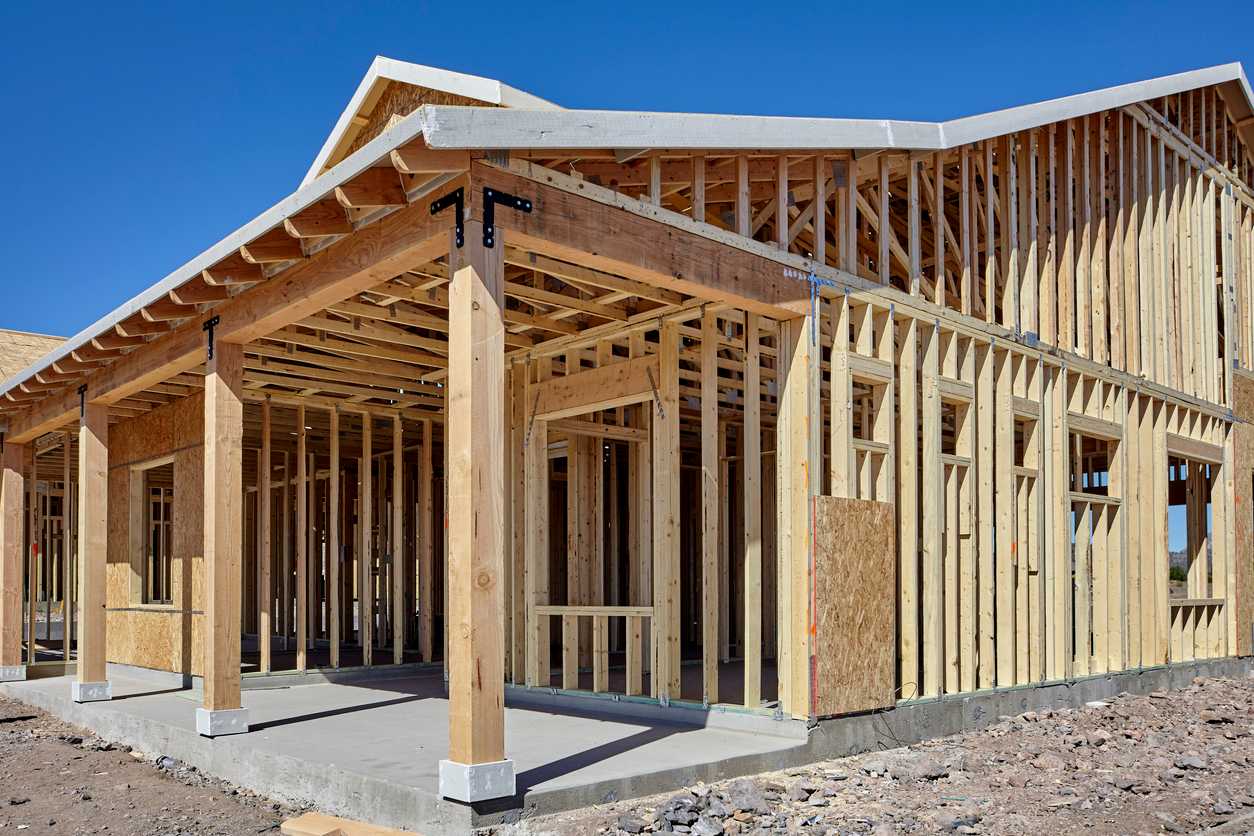Home>diy>Building & Construction>How To Calculate Construction Loan Interest


Building & Construction
How To Calculate Construction Loan Interest
Modified: October 18, 2024
Learn how to calculate construction loan interest for your building construction project. Simplify the complexities and ensure accurate financial planning.
(Many of the links in this article redirect to a specific reviewed product. Your purchase of these products through affiliate links helps to generate commission for Storables.com, at no extra cost. Learn more)
Introduction
Welcome to the world of construction loans and the fascinating realm of interest calculation. If you’re embarking on a construction project, understanding how construction loan interest works is crucial to ensuring a successful and financially sound endeavor.
Construction loans are a type of financing specifically designed for building projects. Unlike traditional mortgage loans, which are used to purchase already-built properties, construction loans provide funds to cover the costs of constructing a new building or renovating an existing one.
One key aspect of construction loans that sets them apart from other types of financing is the way interest is calculated. Unlike traditional loans with fixed interest rates, construction loan interest is typically based on the exact amount borrowed during each construction phase.
In this article, we will dive into the intricacies of construction loan interest and explain the factors that can affect it. We will also guide you through the process of calculating construction loan interest, so you can have a clear understanding of the financial implications of your construction project.
Whether you’re a homeowner looking to build your dream house or a developer working on a commercial project, this article will equip you with the knowledge you need to navigate the world of construction loan interest rates with confidence.
Key Takeaways:
- Understanding construction loan interest is crucial for successful projects. Factors like loan amount, interest rate, and loan term impact the overall cost. Calculating monthly and total interest payments provides clarity and helps in effective financial planning.
- By carefully determining the loan amount and interest rate, borrowers can secure favorable construction loan terms. Understanding the simple interest and interest reserve methods for calculating monthly interest payments is essential for managing construction project finances effectively.
Understanding Construction Loans and Interest
Before delving into the intricacies of construction loan interest, it’s essential to have a solid understanding of construction loans themselves. Construction loans are short-term loans that provide the necessary funds to build or renovate a property. These loans are typically provided by banks or other financial institutions and are tailored specifically for construction projects.
Unlike traditional mortgage loans, where the loan amount is disbursed all at once, construction loans are typically disbursed in phases. This enables the borrower to access the funds as needed throughout the construction process. The loan disbursements are known as “draws” and are usually based on milestones reached in the construction project.
Construction loans come with a variety of terms and conditions, including interest rates. The interest rate on a construction loan is often higher than that of a traditional mortgage loan. This is primarily due to the higher risk involved in construction projects. Construction projects are inherently more complex and carry a greater degree of uncertainty compared to completed properties.
Construction loan interest is calculated differently from traditional loans. Instead of paying interest on the full loan amount from day one, borrowers only pay interest on the funds drawn to date. This method of calculating interest is known as “interest-only” payments, as the borrower is only responsible for paying the interest during the construction phase.
During the construction period, borrowers typically have the option to make interest-only payments or defer the interest payments until the project is completed. The interest payments can be included in the loan amount as part of what is known as an “interest reserve.” The interest reserve is a portion of the loan that is set aside to cover the interest payments during the construction phase.
Understanding how construction loans and interest work is vital for anyone considering a construction project. By familiarizing yourself with the unique aspects of construction loan financing, you’ll be better equipped to make informed decisions and navigate the financial aspects of your construction project successfully.
Factors Affecting Construction Loan Interest
Several factors come into play when determining the interest rate for a construction loan. Understanding these factors is essential to grasp how construction loan interest is calculated and to plan your project accordingly. The key factors that influence construction loan interest rates are:
Loan Amount
The loan amount is the total amount of funds needed to complete the construction project. Construction loan interest rates are often based on a percentage of the loan amount. Typically, the larger the loan amount, the higher the interest rate. Lenders consider larger loan amounts to be riskier, as they represent a higher financial commitment.
Interest Rate
The interest rate itself plays a crucial role in determining the overall cost of the construction loan. Construction loan interest rates can vary depending on various factors, such as the current market conditions, the borrower’s creditworthiness, and the lender’s policies. It’s important to shop around and compare interest rates from different lenders to ensure you secure the most competitive rate for your construction project.
Loan Term
The loan term refers to the duration of the loan. Construction loans are generally short-term loans, with terms ranging from a few months to a few years, depending on the complexity and scale of the project. The loan term can impact the interest rate, as longer-term loans may have higher interest rates due to the increased risk associated with an extended construction period.
Construction Schedule
The construction schedule outlines the timeline for the completion of the project. Lenders consider the construction schedule when determining the interest rate, as longer construction periods increase the risk for both the borrower and the lender. If the project extends beyond the originally planned timeline, it can result in additional costs and potential delays in loan repayment, which may affect the interest rate.
It’s important to note that these factors are interconnected, and changes in one factor can influence the others. For example, if the loan amount increases, it may result in a longer loan term or a higher interest rate.
Understanding the factors that impact construction loan interest rates allows borrowers to better anticipate the financial implications of their construction projects. By carefully considering these factors and working closely with lenders, borrowers can secure favorable interest rates and effectively manage their construction loan expenses.
Calculating Construction Loan Interest
Calculating construction loan interest can seem complex, but it becomes straightforward once you understand the key elements involved. The process involves determining the loan amount, the interest rate, and the method used to calculate interest payments. Let’s break down the steps:
Step 1: Determine the Loan Amount
The loan amount is the total funds you need to complete your construction project. It includes the costs of land acquisition, construction materials, labor, permits, and other related expenses. Before calculating the interest, you must know the exact loan amount you require.
Step 2: Determine the Interest Rate
The interest rate on your construction loan will depend on several factors, as mentioned earlier. Once you have obtained loan offers from different lenders, compare the interest rates to choose the most favorable one for your project. Make sure to consider any points or fees associated with the loan as well.
Step 3: Calculate the Monthly Interest Payment
There are two common methods used to calculate the monthly interest payment for construction loans:
Simple Interest Method:
In this method, the monthly interest payment is calculated by multiplying the loan amount by the interest rate and dividing it by twelve (months). This method assumes that the interest is calculated based on the outstanding loan amount for the specific month.
Interest Reserve Method:
This method involves setting up an interest reserve account, which is a portion of the loan amount set aside to cover the interest payments during the construction phase. The interest reserve is typically funded at loan closing and is used to make interest payments during the construction period. The amount of the interest reserve account is determined based on the estimated monthly interest payments.
Step 4: Calculate the Total Interest Payments
To determine the total interest payments over the duration of the construction loan, multiply the monthly interest payment by the number of months it will take to complete the project. Keep in mind that if the construction schedule extends beyond the initial estimate, the total interest payments will increase accordingly.
It’s important to note that these calculations provide an estimate of the interest payments for your construction loan. The actual interest payments may vary depending on factors such as the draw schedule, interest rate fluctuations, and any changes or delays during the construction phase.
By understanding the steps involved in calculating construction loan interest, borrowers can gain clarity on the financial obligations and plan their budgets accordingly. It’s always recommended to consult with a financial advisor or loan officer to ensure accurate calculations and to address any specific concerns related to your construction project.
Step 1: Determine the Loan Amount
When embarking on a construction project, the first crucial step in calculating construction loan interest is determining the loan amount. The loan amount is the total funds you need to complete your construction project.
To determine the loan amount, you must consider all the expenses associated with the construction project. This includes costs such as land acquisition, architectural and engineering fees, permits, construction materials, labor, and any other related expenses. Take the time to thoroughly evaluate your project’s scope and create a detailed budget that encompasses all these elements.
Start by estimating the costs of acquiring the land for your construction project. If you already own the land, you can exclude this cost from the loan amount calculation. However, if you need to purchase the land, consider including the land acquisition costs in the loan amount.
Next, consider the costs of materials and labor. Research the current market prices of construction materials in your area and factor in the anticipated quantity of materials needed for your project. Obtain quotes from contractors or construction companies to gauge labor costs, keeping in mind that these quotes may vary depending on the complexity and scale of your project.
Don’t forget to include other expenses such as architectural and engineering fees, permits, inspections, insurance, and any miscellaneous costs that may arise during the construction process. It’s essential to allocate sufficient funds for unforeseen expenses that may crop up during construction, as unexpected challenges can impact the overall budget.
Once you have a comprehensive list of all the expenses, add them up to determine the total loan amount needed for your construction project. It’s advisable to include a contingency cushion in your budget to account for potential cost overruns or unexpected hurdles that may require additional funds.
Remember, obtaining an accurate estimate for the loan amount is critical, as it directly affects the interest calculations and the overall financial feasibility of your project. Therefore, it’s recommended to consult with professionals, such as architects, contractors, or financial advisors, to ensure you have an accurate understanding of the costs involved.
By taking the time to determine the loan amount accurately, you can proceed with confidence in calculating the construction loan interest and securing the financing necessary to bring your construction project to life.
Read more: How To Calculate The Construction Area
Step 2: Determine the Interest Rate
Once you have determined the loan amount for your construction project, the next crucial step in calculating construction loan interest is determining the interest rate. The interest rate plays a significant role in determining the overall cost of your loan and can vary depending on several factors.
The interest rate on a construction loan is influenced by market conditions, the lender’s policies, and your creditworthiness. It’s essential to research and compare interest rates from different lenders to ensure you secure the most favorable rate for your construction project.
Start by reaching out to multiple lenders or financial institutions that offer construction loans. Provide them with details about your project and request loan quotes, which should specify the interest rates associated with each loan offer. This will give you a range of interest rates to compare and help you identify the most competitive option.
When considering interest rates, it’s important to understand that construction loans typically have higher interest rates compared to traditional mortgage loans. This is due to the increased risks associated with construction projects, which often involve uncertainties, such as construction delays or cost overruns.
In addition to the interest rate itself, you should also consider any points or fees associated with the loan. Points are upfront fees charged by lenders, each point representing 1% of the loan amount. These points can be paid at closing or rolled into the loan amount, depending on your preference. Keep in mind that points can impact the overall cost of the loan and should be factored into your interest rate assessment.
Your creditworthiness will also play a role in determining the interest rate for your construction loan. Lenders will assess your credit score, credit history, and financial stability to evaluate the level of risk associated with lending to you. Borrowers with higher credit scores are generally offered more favorable interest rates, reflecting a lower perceived risk.
It’s important to note that interest rates can fluctuate over time, so it’s advisable to monitor the market and lock in the interest rate when you are satisfied with the terms offered. Locking in the rate means that the lender guarantees that specific interest rate for a certain period, protecting you from potential future rate increases.
By carefully evaluating the interest rates and considering the points or fees associated with each loan offer, you can select the most competitive option for your construction loan. This step is critical in accurately calculating the construction loan interest and ensuring that you secure the most favorable financing for your project.
Step 3: Calculate the Monthly Interest Payment
Calculating the monthly interest payment is a crucial step in understanding the financial implications of a construction loan. There are two common methods used to calculate the monthly interest payment: the simple interest method and the interest reserve method.
Simple Interest Method:
Under the simple interest method, the monthly interest payment is calculated based on the outstanding loan amount for the specific month. Here’s how it works:
- Start by identifying the loan amount you have drawn for each month of the construction project. This reflects the funds you have used up to that point.
- Multiply the loan amount by the interest rate. Make sure to convert the interest rate to a decimal form (e.g., 5% would be 0.05).
- Divide the result by twelve to obtain the monthly interest payment for that specific month.
It’s important to note that the monthly interest payment will vary throughout the construction period as the loan amount changes. As you draw more funds for construction, the outstanding loan amount increases, resulting in higher monthly interest payments.
Interest Reserve Method:
The interest reserve method involves setting up an interest reserve account as part of the construction loan. The interest reserve is a portion of the loan amount that is set aside to cover the interest payments during the construction phase. Here’s how it works:
- At loan closing, a portion of the loan amount is earmarked for the interest reserve. The specific amount is determined based on the estimated monthly interest payments.
- The interest reserve is typically funded by borrowing extra funds from the lender or through cash that is part of your own contribution to the project.
- During the construction phase, the lender will pay the monthly interest out of the interest reserve account rather than billing you for the interest payment directly.
- Once the construction is complete, you will start making principal and interest payments on the remaining loan balance.
The interest reserve method provides the advantage of not having to make monthly interest payments during the construction phase. Instead, the interest payments are added to the loan amount, allowing you to focus your resources on completing the construction.
Both the simple interest method and the interest reserve method are widely used in calculating the monthly interest payment for construction loans. The method you choose will depend on your financial circumstances and preferences. It’s recommended to consult with your lender or financial advisor to understand the pros and cons of each method and decide which one best suits your needs.
Read more: How To Calculate A Construction In Progress
Step 4: Calculate the Total Interest Payments
Calculating the total interest payments for your construction loan is the final step in understanding the overall cost of borrowing for your project. To calculate the total interest payments, you need to determine the duration of the loan and multiply it by the monthly interest payment. Here’s how:
- Start by determining the duration of your construction loan. The duration is typically expressed in months and can vary depending on the complexity and scope of your construction project.
- Next, calculate the monthly interest payment using the appropriate method: either the simple interest method or the interest reserve method, as discussed in step 3.
- Once you have the monthly interest payment, multiply it by the duration of the loan in months.
This calculation will provide you with the total interest payments over the duration of the construction loan. It’s important to note that this calculation assumes a fixed interest rate throughout the entire loan term and consistent monthly payments.
Total Interest Payment Calculation Example:
Let’s consider an example to illustrate the calculation of total interest payments:
Loan Amount: $500,000
Interest Rate: 5% (0.05 in decimal form)
Loan Duration: 12 months
Using the simple interest method, let’s calculate the monthly interest payment:
Loan Amount x Interest Rate = $500,000 x 0.05 = $25,000
Monthly Interest Payment = $25,000 / 12 = $2,083.33
Now, let’s calculate the total interest payments:
Monthly Interest Payment x Loan Duration = $2,083.33 x 12 = $25,000
In this example, the total interest payments over the 12-month loan duration would amount to $25,000.
Remember that this is just a simplified example, and actual loan terms, interest rates, and loan durations may vary. It’s crucial to consult with your lender to obtain precise calculations based on your specific loan terms.
Calculating the total interest payments for your construction loan allows you to understand the financial commitment and plan your budget accordingly. By having a clear picture of the total interest costs, you can make informed decisions and manage your construction project’s finances effectively.
Conclusion
Calculating construction loan interest is a vital aspect of any construction project, as it helps you understand the financial implications and plan your budget effectively. By following the steps outlined in this article, you can confidently calculate construction loan interest and make informed decisions throughout your construction journey.
Understanding the factors that affect construction loan interest, such as the loan amount, interest rate, loan term, and construction schedule, allows you to navigate the lending process with confidence. By considering these factors and securing the most competitive interest rate, you can minimize your borrowing costs.
Calculating the monthly interest payment using either the simple interest method or the interest reserve method provides clarity on your ongoing financial obligations during the construction phase. Determine which method aligns best with your financial goals and preferences.
Finally, calculating the total interest payments for your construction loan gives you a comprehensive view of the overall cost of borrowing. This allows you to make informed decisions and plan your project expenses accordingly.
Remember, it’s crucial to consult with lenders and financial advisors to obtain accurate calculations based on your specific loan terms and financial circumstances. Each construction project is unique, and professional guidance ensures that you make the most informed decisions.
By taking the time to understand construction loan interest and carefully calculating the financial aspects of your project, you can set a solid foundation for a successful construction journey. With proper planning and financial management, your construction project can thrive and bring your vision to life.
Frequently Asked Questions about How To Calculate Construction Loan Interest
Was this page helpful?
At Storables.com, we guarantee accurate and reliable information. Our content, validated by Expert Board Contributors, is crafted following stringent Editorial Policies. We're committed to providing you with well-researched, expert-backed insights for all your informational needs.












0 thoughts on “How To Calculate Construction Loan Interest”